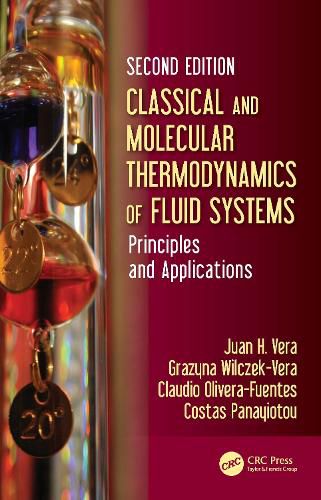Readings Newsletter
Become a Readings Member to make your shopping experience even easier.
Sign in or sign up for free!
You’re not far away from qualifying for FREE standard shipping within Australia
You’ve qualified for FREE standard shipping within Australia
The cart is loading…






This text explores the connections between different thermodynamic subjects related to fluid systems. In an innovative way, it covers the subject from first principles to the state of the art in fundamental and applied topics. Using simple nomenclature and algebra, it clarifies concepts by returning to the conceptual foundation of thermodynamics. The structural elements of classical and molecular thermodynamics of fluid systems presented cover, via examples and references, both the usefulness and the limitations of thermodynamics for the treatment of practical problems. This new edition explores recent advances in statistical associated fluid theories and contains creative end-of-chapter problems connecting the theory with real-life situations. It includes new chapters on thermodynamics of polymer solutions and molecular thermodynamics and also presents advances in the study of the activity of individual ions.
Provides a concise structure of concepts, using simple nomenclature and algebra Clarifies problems usually overlooked by standard texts Features end-of-chapter problems to enhance the reader's understanding of the concepts Includes diverse topics of interest to researchers and advanced students, including elements of statistical thermodynamics, models of solutions, statistical associated fluid theory and the activity of individual ions Offers four appendices giving step-by-step procedures and parameters for direct use of the PRSV equation of state and the ASOG-KT group method for fugacity and activity coefficient calculations Features a complete set of solutions to problems throughout the book, available for download on the book's webpage under "Support Material"
This textbook is written for advanced undergraduate and graduate students studying chemical engineering and chemistry as well as for practicing engineers and researchers.
$9.00 standard shipping within Australia
FREE standard shipping within Australia for orders over $100.00
Express & International shipping calculated at checkout
This text explores the connections between different thermodynamic subjects related to fluid systems. In an innovative way, it covers the subject from first principles to the state of the art in fundamental and applied topics. Using simple nomenclature and algebra, it clarifies concepts by returning to the conceptual foundation of thermodynamics. The structural elements of classical and molecular thermodynamics of fluid systems presented cover, via examples and references, both the usefulness and the limitations of thermodynamics for the treatment of practical problems. This new edition explores recent advances in statistical associated fluid theories and contains creative end-of-chapter problems connecting the theory with real-life situations. It includes new chapters on thermodynamics of polymer solutions and molecular thermodynamics and also presents advances in the study of the activity of individual ions.
Provides a concise structure of concepts, using simple nomenclature and algebra Clarifies problems usually overlooked by standard texts Features end-of-chapter problems to enhance the reader's understanding of the concepts Includes diverse topics of interest to researchers and advanced students, including elements of statistical thermodynamics, models of solutions, statistical associated fluid theory and the activity of individual ions Offers four appendices giving step-by-step procedures and parameters for direct use of the PRSV equation of state and the ASOG-KT group method for fugacity and activity coefficient calculations Features a complete set of solutions to problems throughout the book, available for download on the book's webpage under "Support Material"
This textbook is written for advanced undergraduate and graduate students studying chemical engineering and chemistry as well as for practicing engineers and researchers.